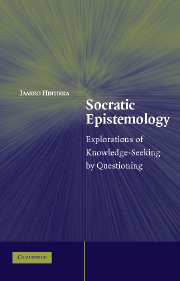Book contents
- Frontmatter
- Contents
- Acknowledgments
- Introduction
- 1 Epistemology without Knowledge and without Belief
- 2 Abduction—Inference, Conjecture, or an Answer to a Question?
- 3 A Second-Generation Epistemic Logic and its General Significance
- 4 Presuppositions and Other Limitations of Inquiry
- 5 The Place of the a priori in Epistemology
- 6 Systems of Visual Identification in Neuroscience: Lessons from Epistemic Logic
- 7 Logical Explanations
- 8 Who Has Kidnapped the Notion of Information?
- 9 A Fallacious Fallacy?
- 10 Omitting Data—Ethical or Strategic Problem?
- Index
- References
8 - Who Has Kidnapped the Notion of Information?
Published online by Cambridge University Press: 05 June 2012
- Frontmatter
- Contents
- Acknowledgments
- Introduction
- 1 Epistemology without Knowledge and without Belief
- 2 Abduction—Inference, Conjecture, or an Answer to a Question?
- 3 A Second-Generation Epistemic Logic and its General Significance
- 4 Presuppositions and Other Limitations of Inquiry
- 5 The Place of the a priori in Epistemology
- 6 Systems of Visual Identification in Neuroscience: Lessons from Epistemic Logic
- 7 Logical Explanations
- 8 Who Has Kidnapped the Notion of Information?
- 9 A Fallacious Fallacy?
- 10 Omitting Data—Ethical or Strategic Problem?
- Index
- References
Summary
In this day and age, the notion of information should be everybody's concern. Ours is supposed to be the information age, and we all share, in different degrees, the problem of coping with a deluge of information flooding over us. Our life is increasingly dominated by computers, which are nothing but machines for processing information. Information can even serve as a commodity (utility) in economics and decision theory. Hence it is important for each of us to master this concept intellectually and to have ways of gaining an overview over the different kinds of information we receive.
To exaggerate but a little, almost everybody has in fact gotten into the act of discussing what they call “information,” except for philosophers. There are communication theorists à la Claude Shannon (Shannon 1948; Shannon and Weaver, 1949; Hartley 1928) and there are logico-linguistic theorists of semantic information like Yehoshua Bar-Hillel (1964). There are uses of the concept of information in science (see, e.g., Brillouin 1956) and in psychology (see, e.g., Attneave 1959), not to mention the role of genetic information in biology. Last but not least, there are computer scientists who are trying to use the tools of their trade to deal with what they call information and what they relate closely to computational complexity. They include prominently Kolmogorov and Chaitin, whose works are listed in the references.
- Type
- Chapter
- Information
- Socratic EpistemologyExplorations of Knowledge-Seeking by Questioning, pp. 189 - 210Publisher: Cambridge University PressPrint publication year: 2007
References
- 1
- Cited by



